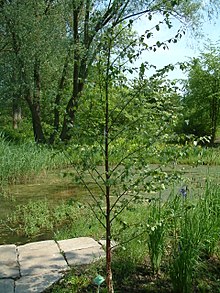Downy birch
| Betula pubescens | |
|---|---|
 |
|
| Scientific classification | |
| Kingdom: | Plantae |
| (unranked): | Angiosperms |
| (unranked): | Eudicots |
| (unranked): | Rosids |
| Order: | Fagales |
| Family: | Betulaceae |
| Genus: | Betula |
| Subgenus: | Betula |
| Species: | B. pubescens |
| Binomial name | |
|
Betula pubescens Ehrh. |
|
 |
|
| Distribution map | |
| Synonyms | |
|
Betula alba |
|
Betula alba
Betula pubescens (syn. Betula alba), commonly known as downy birch and also as moor birch, white birch, European white birch or hairy birch, is a species of deciduous tree, native and abundant throughout northern Europe and northern Asia, growing farther north than any other broadleaf tree. It is closely related to, and often confused with, the silver birch (B. pendula), but grows in wetter places with heavier soils and poorer drainage; smaller trees can also be confused with the dwarf birch (B. nana).
Three varieties are recognised and it hybridises with the silver and dwarf birches. A number of cultivars have been developed but many are no longer in cultivation. The larva of the autumnal moth (Epirrita autumnata) feeds on the foliage and in some years, large areas of birch forest can be defoliated by this insect. A large number of fungi are associated with the tree and certain pathogenic fungi are the causal agents of birch dieback disease.
The tree is a pioneer species, readily colonising cleared land, but later being replaced by taller, more long-lived species. The bark can be stripped off without killing the tree and the bark and the timber is used for turnery and in the manufacture of plywood, furniture, shelves, coffins, matches and toys. The inner bark is edible and can be ground up and used in bread-making, as it still is at Easter in the traditional Finnish mämmi, or eaten in times of famine. The rising sap in spring is used to make refreshing drinks, wines, ales and liqueurs and various parts of the tree have been used in herbal medicine.
Betula pubescens is commonly known as downy birch, with other common names including moor birch, white birch, European white birch or hairy birch. It is a deciduous tree growing to 10 to 20 m (33 to 66 ft) tall (rarely to 27 m), with a slender crown and a trunk up to 70 cm (28 in) (exceptionally 1 m) in diameter, with smooth but dull grey-white bark finely marked with dark horizontal lenticels. The shoots are grey-brown with fine downy. The leaves are ovate-acute, 2 to 5 cm (0.8 to 2.0 in) long and 1.5 to 4.5 cm (0.6 to 1.8 in) broad, with a finely serrated margin. The flowers are wind-pollinated catkins, produced in early spring before the leaves. The fruit is a pendulous, cylindrical aggregate 1 to 4 cm (0.4 to 1.6 in) long and 5 to 7 mm (0.2 to 0.3 in) wide which disintegrates at maturity, releasing the individual seeds; these seeds are 2 mm (0.08 in) long with two small wings along the side.
...
Wikipedia

